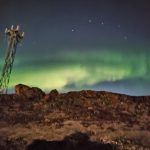
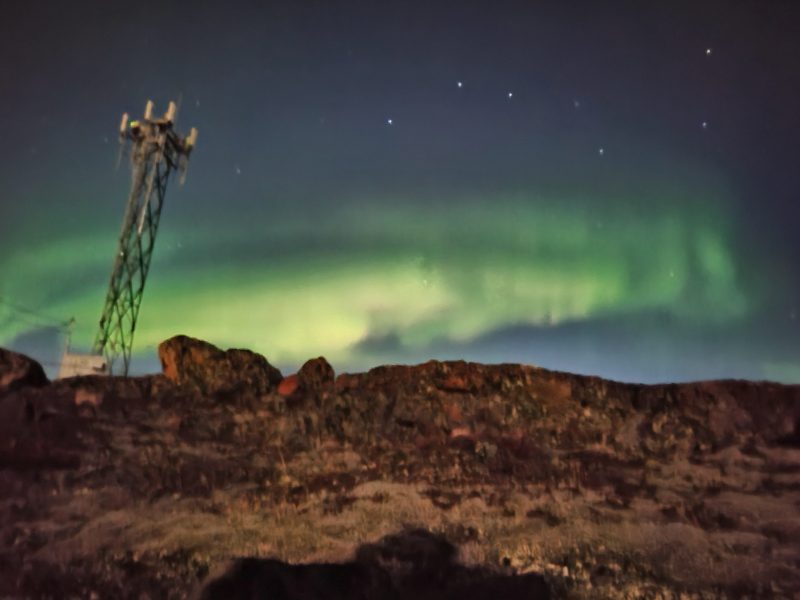
View at EarthSky Community Photos. | Ariel Atienza in Iqaluit, Nunavut, Canada, captured the Big Dipper and a green aurora on this on September 30, 2020.
It’s autumn here in the Northern Hemisphere. There’s a chill in the air, and nights are getting long. Maybe you’ve been standing outside on an autumn evening, looking for the Big Dipper? It’s perhaps the most famous of all star patterns, and – for those at latitudes 41 degrees North or farther north – it’s circumpolar, or always above the northern horizon. If you’re below that latitude, though, you won’t find the Big Dipper in the evening now. In autumn, the Big Dipper is below your horizon during the evening hours.
Want to see it? If you’re in the southern U.S. or a comparable latitude, you’ll want to wait until the hours before dawn. At this time of year, before dawn, you’ll easily see the Big Dipper ascending in the northeast.
To remember the best times to view the Big Dipper in the evening, remember the phrase: spring up and fall down. That’s because the Big Dipper shines way up high in the sky on spring evenings but close to the horizon on autumn evenings.
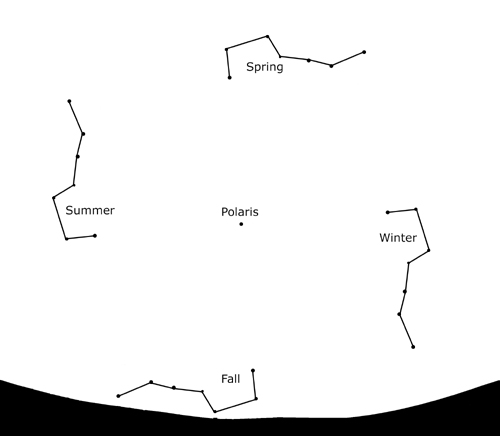
If you’re in the northern U.S., Canada or at a similar latitude, the Big Dipper is circumpolar for you – always above the horizon. These images show the Dipper’s location at roughly 9 p.m. local time April 20 (top), July 20 (west or left), October 20 (bottom) and January 20 (east or right). Just remember “spring up and fall down” for the Dipper’s appearance in our northern sky. It ascends in the northeast on spring evenings, and descends in the northwest on fall evenings. Image via burro.astr.cwru.edu.
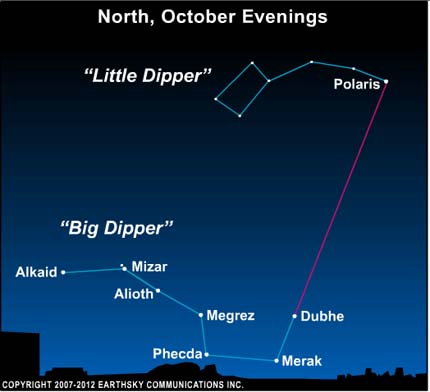
On autumn evenings, from 41 degrees north latitude, or farther north, the Big Dipper rides low in the north on autumn evenings. As always, the 2 outer stars in the Dipper’s bowl point to Polaris, the North Star.
So you might or might not be able to see the Big Dipper now. But you can think about it. Did you know that the distances of the stars in the Dipper reveal something interesting about them? Five of these seven stars have a physical relationship in space. That’s not always true of patterns on our sky’s dome. Most star patterns are made up of unrelated stars at vastly different distances.

The Big Dipper in October by Marc Toso of the website AncientSkys.com.
Five of the Big Dipper’s stars – Merak, Mizar, Alioth, Megrez and Phecda – are part of a single star grouping. They probably were born together from a single cloud of gas and dust, and they’re still moving together as a family.
The other two stars in the Dipper – Dubhe and Alkaid – are unrelated to each other and to the other five. Here are the star distances to the Dipper’s stars:
Alkaid 101 light-years
Mizar 78 light-years
Alioth 81 light-years
Megrez 81 light-years
Phecda 84 light-years
Dubhe 124 light-years
Merak 79 light-years
What’s more, Dubhe and Alkaid are moving in an entirely different direction from the other five stars.
And that’s why – millions of years from now – the Big Dipper will have lost its familiar dipper-like shape.

Astronomers have found that the stars of the Big Dipper (excepting the pointer star, Dubhe, and the handle star, Alkaid) belong to an association of stars known as the Ursa Major Moving Cluster. Here are the stars of the Big Dipper, at their various distances from Earth, via AstroPixie.
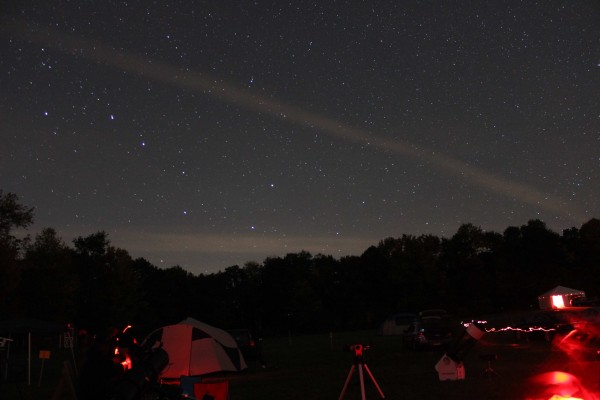
View larger. | Big Dipper on the horizon on an October evening. Kurt Zeppetello caught this image in 2015, while getting set up at the Astronomical Society of New Haven‘s Connecticut Star Party.
Bottom line: If you’re above 41 degrees north latitude, the Big Dipper star pattern is circumpolar; it stays in your sky always, circling around the around the sky’s pole star, Polaris. Below that latitude, the Dipper is below your horizon in the evening in autumn.
from EarthSky https://ift.tt/2GcKJLz


View at EarthSky Community Photos. | Ariel Atienza in Iqaluit, Nunavut, Canada, captured the Big Dipper and a green aurora on this on September 30, 2020.
It’s autumn here in the Northern Hemisphere. There’s a chill in the air, and nights are getting long. Maybe you’ve been standing outside on an autumn evening, looking for the Big Dipper? It’s perhaps the most famous of all star patterns, and – for those at latitudes 41 degrees North or farther north – it’s circumpolar, or always above the northern horizon. If you’re below that latitude, though, you won’t find the Big Dipper in the evening now. In autumn, the Big Dipper is below your horizon during the evening hours.
Want to see it? If you’re in the southern U.S. or a comparable latitude, you’ll want to wait until the hours before dawn. At this time of year, before dawn, you’ll easily see the Big Dipper ascending in the northeast.
To remember the best times to view the Big Dipper in the evening, remember the phrase: spring up and fall down. That’s because the Big Dipper shines way up high in the sky on spring evenings but close to the horizon on autumn evenings.

If you’re in the northern U.S., Canada or at a similar latitude, the Big Dipper is circumpolar for you – always above the horizon. These images show the Dipper’s location at roughly 9 p.m. local time April 20 (top), July 20 (west or left), October 20 (bottom) and January 20 (east or right). Just remember “spring up and fall down” for the Dipper’s appearance in our northern sky. It ascends in the northeast on spring evenings, and descends in the northwest on fall evenings. Image via burro.astr.cwru.edu.

On autumn evenings, from 41 degrees north latitude, or farther north, the Big Dipper rides low in the north on autumn evenings. As always, the 2 outer stars in the Dipper’s bowl point to Polaris, the North Star.
So you might or might not be able to see the Big Dipper now. But you can think about it. Did you know that the distances of the stars in the Dipper reveal something interesting about them? Five of these seven stars have a physical relationship in space. That’s not always true of patterns on our sky’s dome. Most star patterns are made up of unrelated stars at vastly different distances.

The Big Dipper in October by Marc Toso of the website AncientSkys.com.
Five of the Big Dipper’s stars – Merak, Mizar, Alioth, Megrez and Phecda – are part of a single star grouping. They probably were born together from a single cloud of gas and dust, and they’re still moving together as a family.
The other two stars in the Dipper – Dubhe and Alkaid – are unrelated to each other and to the other five. Here are the star distances to the Dipper’s stars:
Alkaid 101 light-years
Mizar 78 light-years
Alioth 81 light-years
Megrez 81 light-years
Phecda 84 light-years
Dubhe 124 light-years
Merak 79 light-years
What’s more, Dubhe and Alkaid are moving in an entirely different direction from the other five stars.
And that’s why – millions of years from now – the Big Dipper will have lost its familiar dipper-like shape.

Astronomers have found that the stars of the Big Dipper (excepting the pointer star, Dubhe, and the handle star, Alkaid) belong to an association of stars known as the Ursa Major Moving Cluster. Here are the stars of the Big Dipper, at their various distances from Earth, via AstroPixie.

View larger. | Big Dipper on the horizon on an October evening. Kurt Zeppetello caught this image in 2015, while getting set up at the Astronomical Society of New Haven‘s Connecticut Star Party.
Bottom line: If you’re above 41 degrees north latitude, the Big Dipper star pattern is circumpolar; it stays in your sky always, circling around the around the sky’s pole star, Polaris. Below that latitude, the Dipper is below your horizon in the evening in autumn.
from EarthSky https://ift.tt/2GcKJLz

Aucun commentaire:
Enregistrer un commentaire